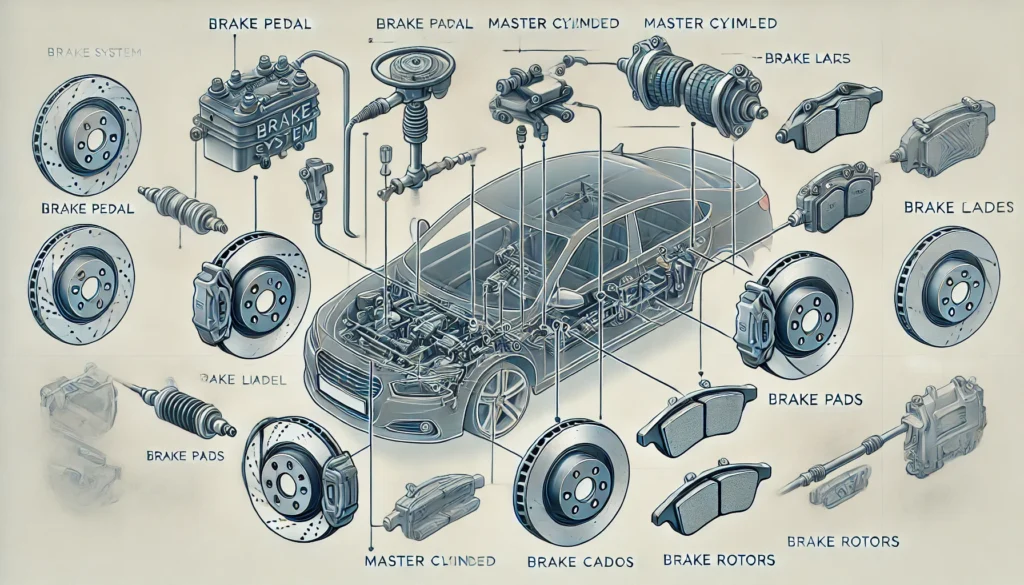The brake system is one of the most crucial components of a vehicle, ensuring the safety of the driver, passengers, and others on the road. When a brake system fault occurs, it’s essential to diagnose and repair it promptly to maintain optimal performance and safety. This article outlines the steps to diagnose a brake system fault effectively.
Understanding the Brake System
The brake system comprises several key components that work together to slow down and stop the vehicle:
- Brake Pedal: The driver presses this to initiate braking.
- Master Cylinder: Converts mechanical force from the pedal into hydraulic pressure.
- Brake Lines and Hoses: Transmit hydraulic fluid to the brake calipers.
- Brake Calipers: House the brake pads and apply pressure to the rotors.
- Brake Pads: Create friction against the rotors to slow the vehicle.
- Brake Rotors (Discs): Rotating discs that the pads clamp onto to create friction.

Steps to Diagnose a Brake System Fault
- Inspect the Brake Fluid Level:
- Check the brake fluid reservoir under the hood. Ensure the fluid level is within the recommended range. Low brake fluid can indicate a leak or worn brake pads.
- Check for Leaks:
- Inspect the brake lines, hoses, and calipers for any signs of brake fluid leaks. Look for wet spots or fluid stains around these components. Leaks can reduce hydraulic pressure and compromise braking efficiency.
- Examine the Brake Pads and Rotors:
- Inspect the brake pads for wear. Thin or worn-out pads need to be replaced. Also, check the rotors for grooves, cracks, or warping. Damaged rotors can affect braking performance and should be resurfaced or replaced if necessary.
- Test the Brake Pedal Feel:
- Press the brake pedal and observe how it feels. A spongy or soft pedal can indicate air in the brake lines or a problem with the master cylinder. A firm pedal that requires excessive force might indicate a blockage or a failing brake booster.
- Listen for Unusual Noises:
- Pay attention to any unusual sounds when braking, such as squeaking, grinding, or clicking. These noises can indicate worn brake pads, damaged rotors, or loose components.
- Check the Brake Warning Light:
- If the brake warning light is on, use an OBD-II scanner to read any diagnostic trouble codes (DTCs) stored in the vehicle’s computer. These codes can help pinpoint specific issues within the brake system.

Common Causes of Brake System Faults
Several factors can lead to brake system faults, including:
- Worn Brake Pads:
- Over time, brake pads wear down and need to be replaced. Regular inspection and timely replacement are essential for maintaining braking performance.
- Brake Fluid Leaks:
- Leaks in the brake lines, hoses, or calipers can reduce hydraulic pressure, leading to reduced braking efficiency or brake failure.
- Air in the Brake Lines:
- Air can enter the brake lines during repairs or if there’s a leak. This can cause a spongy brake pedal and reduced braking performance.
- Faulty Master Cylinder:
- The master cylinder can wear out or fail, leading to inconsistent brake pressure and compromised braking performance.
- Damaged Rotors:
- Rotors can become warped, cracked, or grooved due to excessive heat or wear. Damaged rotors affect braking smoothness and efficiency.
Importance of Prompt Diagnosis and Repair
Addressing brake system faults promptly is crucial for vehicle safety. Ignoring these issues can lead to brake failure, longer stopping distances, and increased risk of accidents. Regular maintenance and immediate attention to any signs of brake problems can ensure your vehicle remains safe and reliable.
Conclusion
Diagnosing a brake system fault involves inspecting various components, testing the brake pedal feel, listening for unusual noises, and using diagnostic tools. Understanding the common causes of brake system faults and addressing them promptly can ensure your vehicle’s braking system remains effective and safe. Regular maintenance and timely repairs are essential for optimal vehicle performance and safety.